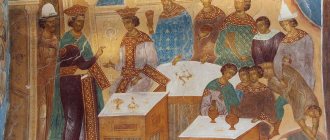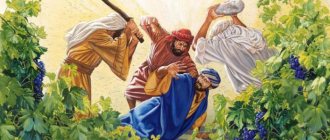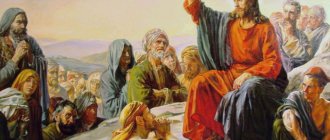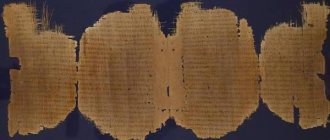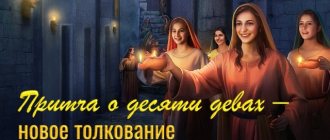Interpretation of the Gospel for every day of the year
Luke, 38, 8, 26-39
Then they sailed to the country of the Gadarenes, which lies opposite Galilee. When Jesus came ashore, he was met by a man from the city who had been possessed by demons for a long time, and who had not put on clothes, and who lived not in a house, but in tombs. When he saw Jesus, he cried out, fell down before Him and said in a loud voice: What have you to do with me, Jesus, Son of the Most High God? I beg You, do not torment me. For Jesus commanded the unclean spirit to come out of the man, because it had tormented him for a long time, so that they bound him with chains and bonds, keeping him safe; but he broke the bonds and was driven by the demon into the desert. Jesus asked him: What is your name? He said: legion, because many demons entered into it. And they asked Jesus not to command them to go into the abyss. There was also a large herd of pigs grazing on the mountain; and the demons asked Him to allow them to enter into them. He let them. The demons came out of the man and entered the pigs, and the herd rushed down a steep slope into the lake and drowned. The shepherds, seeing what had happened, ran and told it in the city and in the villages. And they came out to see what had happened; and when they came to Jesus, they found the man from whom the demons had gone out, sitting at the feet of Jesus, clothed and in his right mind; and were horrified. Those who saw them told them how the demoniac was healed. And all the people of the Gadarene region asked Him to leave them, because they were seized with great fear. He entered the boat and returned. The man from whom the demons had come out asked Him to be with Him. But Jesus sent him away, saying, “Return to your house and tell us what God has done for you.” He went and preached throughout the whole city what Jesus had done for him.
Today's Gospel tells us that the power of demons can be very great; it can threaten the existence of every person and all of humanity. So that no one thinks that if he lives without God, then he will somehow cope with life on his own. As soon as a person finds himself without God, he finds himself with the devil. And to what extent this demonic power extends, we see in the example of the Gadarene demoniac and the entire country in which this unfortunate man is located. The absolute power of demons over a person, so that this person lives in his madness, without putting on clothes, naked from everything reasonable and good. Not to mention the fact that he is deprived of grace. And he lives not just anywhere, but in coffins. The most suitable home for him was the caves where dead people were placed, touching which meant uncleanness for the living.
He is so under the power of demons that he no longer exists. "What's your name?" - asks the Lord. “Legion,” this man answers, or rather, the demons are already answering for him. Whenever a person departs from God, he loses himself, his personality. And the devil certainly operates in his life, whether a person notices it or not.
It is said about this demoniac that he terrorized everyone who passed by on the roads, just as some bandits can terrorize - who are bandits because they are possessed by demons. Where there is no presence of God, these demons and these people behave extremely arrogantly: they humiliate those around them, being themselves humiliated by the demonic power that controls them. And where the presence of Christ is, they tremble with fear, humbly asking, like criminals before a court, that their fate might somehow be mitigated.
The Lord shows us today that dependence on demonic power among a person, among a people, among the human race can be extreme.
Let us pay attention to the fact that these creatures are not only monstrously strong, but also extremely freedom-loving. For them, any restriction of their freedom is intolerable. They break the iron chains that bind them, any bonds, because they want to live freely. The entire culture and spirituality of our time is aimed at raising a person absolutely free, independent of any restrictions, so that no one and nothing controls him. So that a person is under the complete power of demons.
The freedom that was proclaimed in 1917 and the freedom that is being proclaimed now - freedom from everything - means precisely this phenomenon, when a person is ready to break any obstacles like chains, just to achieve it. There are no commandments, no morality, no boundaries, no authority. And such a man runs madly, driven by a demon, into the desert.
“What do I and You, Son of God?” - ask the demons who see God in front of them. “What do you and us have in common?” Indeed, what is common between light and darkness, what is common between Christ and Belial? There is nothing in common. There is nothing in common between demons and God. And between man and God there is always something in common. No matter what state a person is in, there is something in common between a person and God, and God still protects a person, despite the fact that he has fallen under the power of demons, and does not leave him to the end.
There is nothing in common between pigs and God. These are just some kind of slurping, drinking, eating creatures. Demons want people to become pig-like, then they can move into them and destroy them. So that people become a beastly herd, as they want to make all our people today, so that demons move into this herd, and it rushes down a steep slope into the water and drowns. Demons want to destroy the entire human race.
We see what power they have and what hatred they have for man. The meaning of their existence is to destroy and destroy. It is not possible to destroy this person - so at least the pigs, what belongs to man. Maybe through this it will be possible to rebel a person against God? And it turns out that it succeeds. The whole country, because it is losing its prosperity, is rebelling against God.
Today we must see not only the power of God, but we must be amazed at how great the love of the Lord is. In an instant the devil would destroy each of us and everyone. And it seems that there is reason for him to have power over people for their sins. But God's love puts a limit to this hatred of man. The love of Christ does not leave a person, no matter what.
We will always know this - not abstractly, but realistically - by looking at what is happening today in our country. Because the most terrible thing is, of course, not external disasters, not hunger, not poverty, but the madness of people. They want to turn people into beasts so that they will completely belong to demons. But God’s love still surpasses everything—God has all the power. Satan cannot do anything without God's permission in any situation. If a person turns to the Lord with all his heart, if the people turn to Him, then everything will immediately change, just as it changed with this demon-possessed man.
We see that a man, dressed and intelligent, as it is said, sits at the feet of Christ. A reasonable person who controls himself, who becomes himself. Now the world doesn’t talk about anything else except how a person can become himself - that is, a free person, independent of anything. But it turns out that a person can become himself only when he is a man of God. And when he renounces God, we see how much freedom he achieves and how much he loses himself.
Each person has different degrees of this loss of himself, but in the end, there can be no middle ground: either a person must become God's, or he must become with the devil forever, forever and ever.
We see that all the people of this wonderful country, after the shepherds, having seen what had happened, ran and told them everything, come out to meet Christ, overcome with fear, and ask Him to move away from these places. What are they afraid of? Firstly, they are scared because they have lost property, all their material wealth. But they are also gripped by another, also understandable fear. They are still people, not completely under the power of demons, and they have the same fear that Simon Peter once had. When the Lord showed him a miracle of catching fish, he fell at the feet of Christ and said: “Get away from me, Lord, because I am a sinful man.” No, they do not yet confess themselves to be sinners - this is a pagan country, that’s why there are pigs there - but the Lord, walking on the earth, is already reaching this darkness.
And what happens to the healed person? Never, not for anything, not for one moment does he want to part with the Lord. He wants to be with His disciples and go where the Lord goes. But the Lord tells him that He does not take him with him, so that he will go again to the very land of the Gadarenes, where he had been before, preaching about what Christ has done for him. He is afraid to think that he will again find himself among these pig-loving people who reject Christ and ask Him to leave these places. But the Lord, nevertheless, sends him there to preach about how merciful the Lord is, what great miracles He can perform where, it seems, everything is completely hopeless.
Isn’t everything still lost, we say today, is it really not all over with our Gadarene country? In spite of everything, in spite of all the madness that has existed and continues today, despite the ever-increasing expulsion of Christ from our country, despite this swinishness that is increasingly spreading among the people, the Lord does not leave our country, but sends here people whom He healed, to whom He made them know how great the power and mercy of the Lord are, preaching that all is not lost.
The example of this healed demoniac says that we must be ready, if the Lord has granted us to recognize His grace, His true life, to prefer the gifts of consolation, the gifts of grace of always being with the Lord, the path to the land where hell really is, in order to bring to the God of other people. And we must, looking at this event, which is shown in the Gospel, remember that it is possible for the Lord to change everything where there seems to be no hope for healing. No matter what obstacles stand in our way, the Lord says that He contains everything with His power. He sends this man to a country that has just rejected Him in order to enlighten them with the light of truth, so that when the time comes, they too will be granted salvation.
The miracle of today's Gospel - what the Lord can do with every person and with all humanity - is revealed in full in the mystery of the Cross of Christ and His Resurrection. And each of us is called to fulfill God’s will for ourselves and to be a participant in the will of God, which wants all people to be saved.
https://www.pravoslavie.ru/put/071111110024
Russian Orthodox Church
On September 24-28, 2021, the First International Conference “The Gospel of Matthew: Historical and Theological Context” was held in Moscow, which was prepared and conducted by the All-Church Postgraduate and Doctoral Studies named after Saints Cyril and Methodius, Equal-to-the-Apostles, together with the international Society for New Testament Studies (SNTS), as well as the Higher School of Economics (HSE).
Metropolitan Hilarion of Volokolamsk, the rector of the Central Orthodox Church, gave a plenary report on the topic “The Gospel of Matthew in the Church Tradition and in Modern Science.”
Dear conference participants! Dear fathers, brothers and sisters!
Our meeting is dedicated to the first book of the New Testament canon - the Gospel of Matthew. It is often called the “Gospel of the Church,” primarily because it was much more famous in the early Church than the Gospels of Mark and Luke. From the earliest periods of Christian history it has attracted the greatest attention of exegetes. At the beginning of the 2nd century, Ignatius the God-Bearer already referred to it, and in the first half of the 3rd century, Origen wrote a full commentary on it. In the 4th century, John Chrysostom compiled a complete commentary on it. It is not surprising that in modern times, during the era of the formation of academic New Testament biblical studies, this Gospel became the subject of debate. In my report, I would like to identify and evaluate the contradictions in the assessment of the origin, dating and content of this Gospel that exist between church tradition and modern biblical scholarship. I would like to offer my thoughts on the Church Tradition that preserves information about the origin of the Gospel of Matthew, and call for greater confidence in this evidence. In addition, I would like to assess the significance of the contradictions between Church Tradition and academic biblical studies for modern Orthodox theology.
In the first part of my report, I will describe the image of the author of the Gospel of Matthew, which can be reconstructed on the basis of the Gospel text itself. In this part I will rely on the presentation given in the first volume of my study on Jesus Christ. In the second part, I will consider the evidence for the origin of the Gospel of Matthew, which can be gleaned from the Tradition of the Church, and analyze it from the standpoint of the criterion of theological conditionality. In conclusion, I will present my thoughts on the theological “background” of the Gospel narrative, starting from the discussion around the concept of the Church in the Gospel of Matthew.
1. The Gospel of Matthew: what does the text say about its author?
Let us begin by presenting positions that are obvious from the Gospel text itself and which can be considered consensus both for the church tradition and for the scientific community.
What can you tell from the text of the Gospel of Matthew about its author? It is obvious that he is a Jew, well acquainted with the Jewish environment and the traditional interpretation of the Old Testament for this environment. Abundant quoting of the Old Testament is also characteristic of other Evangelists, but Matthew stands out among them in that he most consistently pursues the idea of the fulfillment of Old Testament prophecies in the life of Jesus as the promised Messiah.
The Gospel of Matthew differs in composition from the other two synoptic Gospels. Significant space is devoted to the speeches of Jesus. There are five such speeches in it: the Sermon on the Mount (Matthew 5:3-7:27); instruction to the disciples (Matthew 10:5-42); teaching in parables (Matt. 13:3-52); another instruction to the disciples (Matthew 18:3-35); prophecies and parables about the end times (Matthew 24:3-25:46). Each of these speeches is stitched together with the subsequent narrative using the formula “When Jesus finished these words” (Matt. 7:28; 19:1) or something similar (Matt. 11:1; 13:53; 19:1). The fifth teaching is followed by the words of the Evangelist: “When Jesus had finished all these words...” (Matthew 26:1). Thus, Matthew places special emphasis on Jesus' teaching ministry, embedding several lengthy speeches into the narrative fabric.
Matthew, more than the other Evangelists, emphasizes the royal dignity of Jesus. It is no coincidence that in the very first verse he calls Him “the son of David,” emphasizing His descent from the royal family:
Matthew shows the Messiah as King—crowned, rejected, and coming again. In this Gospel, like no other, Jesus is depicted in royal colors. His lineage is determined by the royal line of Israel, His life is threatened by an envious king, the wise men from the East bring royal gifts to the baby Jesus, and John the Baptist proclaims Him King and proclaims that His Kingdom is at hand. Even temptations in the wilderness reach their climax when Satan offers Christ all the kingdoms of the world for his possession. The Sermon on the Mount is a manifesto of the King, miracles confirm His royal regalia, and many of the parables reveal the secrets of His Kingdom. In one of the parables, Jesus compares Himself to the son of a king and later enters Jerusalem royally. In the face of death on the cross, He foretells His future reign and declares power over the angels of heaven. His last words affirm that all authority in heaven and on earth has been given to Him (Matthew 28:18)1.
The text of the Gospel of Matthew indicates that its main addressee was Jewish readers. This is confirmed by numerous examples. In particular, Matthew calls Jerusalem the “holy city” (Matt. 4:5). Mark and Luke would probably have explained which city they were talking about; for Matthew and his readers it is clear that the holy city is Jerusalem, because for the Jews there was no other “holy city” in the universe, just as there was no other temple except the temple of Jerusalem.
In the Gospel of Matthew there are many Aramaic words left without translation, for example: “Whoever says to his brother “raqa” is guilty of fiery hell” (Matthew 5:22); “You cannot serve God and mammon” (Matthew 6:24). Borrowings from Hebrew or Aramaic are also found in Mark, but Mark, as a rule, translates them (for example, Mark 5:41), and Matthew in a number of cases considers this unnecessary, since, obviously, his readers, unlike the readers Mark, the meaning of these words was known.
Many events in the life of Jesus are presented in Matthew as the fulfillment of Old Testament prophecies. We also find allusions to the Old Testament and quotes from it in other Evangelists, but their share in Matthew is much greater: in his Gospel we find about 60 such quotes and allusions, while, for example, in Mark there are three times less.
The Gospel of Matthew contains parallelisms characteristic of Semitic literature. For example: “He who saves his life will lose it; but he who loses his life for My sake will save it” (Matthew 10:39). As is well known, parallelism is especially characteristic of Hebrew poetry: in many psalms, the verses are clearly divided into two parts, parallel to one another (for example, in Psalm 50). It is obvious that these parallelisms reflect one of the precious features of Jesus' oral speech preserved by Matthew.
A characteristic technique of Jewish poetry is the use of a particular phrase as a refrain. In Matthew, when reproducing the speech of Jesus, formulas such as, for example, “by their fruits you will know them” are repeated many times (Matthew 7:16, 20), “there will be weeping and gnashing of teeth” (Matthew 8:12; 13:42 ; 22:13), “woe to you, scribes and Pharisees, hypocrites” (Matt. 23:13-15, 23, 25, 27), “fools and blind” (Matt. 23:17, 19). These refrains also reflect one of the features of Jesus' speech.
An example that confirms that the Gospel of Matthew was addressed primarily to a Jewish audience is the words of Jesus: “Pray that your flight does not happen in winter or on the Sabbath” (Matthew 24:20). The mention of the Sabbath had meaning only for the Jews, for whom fleeing on the Sabbath meant violating the commandment of Sabbath rest.
The Gospel of Matthew begins where the Old Testament ends. The last book of the section “Neviim” (Prophets) - the Book of Malachi2 - ends with a prophecy, which in the Christian tradition is interpreted as referring to John the Baptist. Matthew begins his story with the birth of Jesus and the preaching of John the Baptist. Perhaps this, as well as the general orientation of the Gospel of Matthew, the addressee of which was primarily Jewish Christians, became the reason that this Gospel was placed in first place in the canon of the New Testament, as if connecting the Old Testament with the New.
The theme of the relationship between the two Testaments is one of the central themes in Matthew. It is in his presentation that Jesus builds His main teaching - the Sermon on the Mount - on a comparison of the moral postulates He offers with the commandments of the Law of Moses: “You have heard what was said to the ancients... But I say to you...” (Matthew 5:21; 5:27; 5 :33; 5:38; 5:43). Moreover, only in Matthew Jesus says: “Do not think that I came to destroy the law or the prophets: I came not to destroy, but to fulfill... Until heaven and earth pass, not one jot or one tittle will pass from the law until it is fulfilled.” everything” (Matt. 5:17-18). Only in Matthew does Jesus emphasize the importance of the Old Testament law, while in the other two synoptics this motive is virtually absent.
Moreover, in Matthew, Jesus, although he criticizes the Pharisees, still says that they must be obeyed: “The scribes and Pharisees sat in the seat of Moses; So whatever they tell you to observe, observe and do; But do not follow their works” (Matthew 23:2-3). We will not find such advice in any other Gospel.
Jesus' disputes with the Pharisees, recorded in the Gospel of Matthew, often touch on topics related to the interpretation of Old Testament law. Representatives of various schools of rabbinic thought of His era waged similar disputes among themselves. A reflection of these disputes can be seen in the words of Jesus about the oath of the temple or the golden temple, the altar or the gift that is on it, about the tithe of mint, anise and cumin; about the outside and inside of a cup or dish (Matt. 23:16-26). For the readers of Mark and Luke this issue was irrelevant, whereas the intended reader of Matthew would have known the context in which Jesus developed His thoughts.
2. Tradition of the Church about the writing of the Gospel of Matthew and the criterion of theological conditionality
These are the indirect evidence about the author of the Gospel of Matthew that the Gospel text itself gives us. We can draw conclusions about his origin and worldview, but to all other questions, without which further discussion is impossible: the identity of the author, time, geographical scope and the reason for writing the text - the biblical text does not give us obvious answers.
At the same time, the answers to these questions were kept and transmitted by the Church from the earliest times, and if we trace the thread of church tradition, we will come almost to New Testament times. In fact, the earliest church evidence for the authorship of the first book of the New Testament canon is almost as ancient as the earliest manuscript evidence for the New Testament itself. It dates back to the second half of the 2nd century. and belongs to the holy martyr Irenaeus of Lyons. This text is well known, but we find it appropriate to quote it here:
Matthew published the scriptures of the Gospel among the Jews in their own language, while Peter and Paul in Rome preached the gospel and founded the Church. After their departure, Mark, Peter's disciple and translator, gave us in writing what was preached by Peter. And Luke, Paul's companion, set forth in a book the Gospel he preached. Then John, the disciple of the Lord, reclining on His chest, also published the Gospel during his stay in Ephesus of Asia.
This text belongs to a man who set himself the task of presenting Church Tradition in opposition to the numerous heresies that arose at that time. The text shows that already in the 2nd century there was a stable understanding of how the four Gospels were created and about their authors. If we add to this that Irenaeus of Lyons was a student of Polycarp of Smyrna, a student of the Apostle John the Theologian, then we receive evidence that practically connects us with apostolic times.
In the testimony of St. Irenaeus we see four points that complement the gospel testimony and are not derived from it:
1) the author of the Gospel was the apostle Matthew of the twelve;
2) The Gospel of Matthew was written first among all the canonical Gospels;
3) it was written at the time when Peter and Paul were founding the church in Rome, therefore between the years 45 and 65;
4) it was written in the language of the Jews, that is, Hebrew or Palestinian Aramaic.
As is well known, all of these points have been questioned in modern academic biblical scholarship. Most modern researchers are inclined to believe that the Gospel of Matthew appeared after the Gospel of Mark and after the destruction of Jerusalem in 70. B. Streeter's hypothesis that the Gospel of Matthew was written around 85 AD turned out to be very tenacious. in Antioch. The main argument in favor of this dating is that the words of Jesus quoted in Matthew contain a clear indication of the destruction of the Jerusalem temple (Matthew 24: 1-2). This argument presupposes the idea that Jesus Christ lacked the gift of prophecy. In other words, he proceeds from a predetermined ideological premise, which actually replaces historical evidence.
However, is it possible to deny historicity to Church Tradition only on the grounds that it is an object of faith? We know well that in the absence of evidence of the earliest history of the creation of the biblical text, researchers inevitably turn to tradition. Let's say we have no early evidence of the writing of prophetic texts of the Old Testament or the Torah that would have arisen outside the Jewish tradition itself. Even such monumental discoveries as the discovery of the Dead Sea Scrolls cannot shed light on questions such as the origins of the books of Ezekiel or Micah. A similar situation occurs with many New Testament texts. Under these conditions, researchers were forced to formulate criteria for the reliability of evidence by which one or another piece of evidence from a biblical text or tradition could be assessed. These criteria can be boiled down to one main point: can we expect that there is any theological concept behind this or that evidence? Is it possible to say that this or that evidence serves someone’s interests? For example, even critics of Christianity admit that the story of Peter’s abdication could not meet the interests of early Christian communities, because it showed in an unfavorable light the greatest of the preachers of Christianity, who was also considered the founder of the Roman Church. On the contrary, the thesis that Jesus Christ had 12 main disciples has been questioned by many researchers because it is seen as influenced by a certain theological position: the 12 apostles symbolize Israel. It is for this reason that Joseph Klausner, the first Jewish historian to turn to New Testament studies, considered the testimony of the Talmud more reliable, according to which Jesus had 5 disciples: this number, according to the researcher, is not deducible from any theological concept, does not meet anyone’s interests and , therefore, should be considered more reliable.
Leaving aside the question of the validity of such a judgment about the apostles (why couldn’t Jesus choose exactly 12 disciples for Himself, consciously correlating their number with the 12 tribes of Israel? Moreover, from the Gospels we know that He himself made such a comparison), let’s focus on this criterion - I would call it the “criterion of theological conditionality” - and we will try to apply it to the evidence of the early Church about the origin of the Gospel of Matthew. We have identified 4 points on which the testimony conveyed through Irenaeus of Lyons complements Scripture. Could there be anyone's interest behind at least one of them? Let us turn to the first point - the authorship of Matthew. The recognition of authorship by the apostle, an eyewitness of Jesus Christ, certainly gave the text a kind of advantage as written by an eyewitness of the Gospel events. The Gospel of Mark did not have this advantage, and it might be assumed that for this reason it fell into the background. However, we see that the Gospel of Luke from this point of view is even more inferior to the Gospel of Mark: according to Church Tradition, Luke was strongly influenced by the Apostle Paul, who himself was not a disciple of Jesus Christ. Nevertheless, this Gospel has always enjoyed enormous influence in the Church.
Further, it is not clear why the personality of Matthew was given such great importance if his authorship is considered only a legend. It is unclear what significance the identity of the former tax collector must have had for the Jewish community to which the Gospel of Matthew was addressed. Apart from Matthew’s former profession, nothing is known about his life from ancient Christian sources. We quite clearly understand the mechanism of the emergence of pseudepigrapha: this or that work, as a rule, is inscribed with the name of a famous author or legendary character, so that the work receives an authoritative status. In the case of the Gospel inscribed with the name of Matthew, we see no reason to choose just such an author. If the Gospel of Matthew was considered a text written for the Palestinian Jewish community, then it would have been much more natural to inscribe it with the name of James, the brother of the Lord (we know that this is exactly what happened with the apocryphal text telling about the childhood of Mary, which became known as the First Gospel of James). ). It must be admitted that, based on the criterion of theological conditionality, we find no compelling reason to doubt the authorship of Matthew.
The next point is the primacy of the Gospel of Matthew among the other Gospels. In this case, it is also unclear what theological reasons could have prompted the ancient Church to declare the Gospel of Matthew to be the first in time. The only possible basis is the tradition that Matthew wrote for the Jewish community: since the Jerusalem Church was the center from which the worldwide preaching of the Gospel began, the appearance of the first written Gospel should have been associated with this Church.
The third point is the time of creation of the Gospel of Matthew. According to the tradition recorded by Irenaeus of Lyons, Matthew wrote his Gospel at the time when the apostles Peter and Paul were preaching in Rome. This dating seemed to have a clear theological basis: as eyewitness accounts, the Gospels must have been written down quite early. However, a more detailed examination shows that the church tradition set forth by Irenaeus has deeper foundations. An example of a purely theological approach to dating the Gospels is the preface of Theophylact of Bulgaria to his commentary on the Gospel of Matthew. According to Theophylact, all the Synoptic Gospels were written down in a very short period of time and during the lifetime of most of the apostles: Matthew wrote his Gospel in the eighth year after the Ascension of Christ, Mark in the tenth, and Luke in the fifteenth. On the contrary, the testimony of Irenaeus of Lyons sets a lower limit, before which the Gospels could not have been written: this is the preaching of the apostles Peter and Paul in Rome. In other words, during the first three missionary journeys of the Apostle Paul, not a single Gospel had yet been compiled. Indeed, the authors of the epistles almost never quote the Gospels as a literary source, while the Old Testament is quoted quite abundantly in the apostolic epistles. This could be due to the fact that the Gospels did not yet exist in a clearly recorded written form at the time of the appearance of the apostolic epistles, including the epistles of the Apostle Paul, or that they did not receive universal circulation within the Church. We see that the tradition set forth by Irenaeus of Lyons is consistent with the text of the New Testament itself and cannot be explained by the criterion of theological conditionality.
If we turn to the words of Irenaeus of Lyons about the Gospel of Mark, we will see that it dates back quite late - the time “after the departure” of Peter and Paul, that is, after the year 65, very close to the time of the Jewish War and the destruction of Jerusalem. We see that St. Irenaeus (unlike many modern biblical scholars, both secular and ecclesiastical) did not see a theological problem in the late dating of the Gospel of Mark. From the point of view of theological conditionality, he should have dated both Gospels much earlier. And Irenaeus of Lyons had more than enough reasons for such a conditionality, because he was faced with the task of proving to the Gnostics the truth of the canonical Gospels, and it was St. Irenaeus is famous for his purely theological arguments that there can only be four Gospels, and that their number has prototypes already in the Old Testament.
Finally, the last item on our list is the original language of the Gospel of Matthew. By setting forth the tradition that the first Gospel was written in the language of the Jews, Irenaeus of Lyons put himself in a rather dangerous position: while proving to the Gnostics that only the canonical Gospels are authentic, Irenaeus at the same time argued that members of the Church were not dealing with the original Gospel of Matthew, and with translation. Moreover, at the time of Irenaeus, there were still Gnostic communities of the Judeo-Christian persuasion that used the Hebrew text, which was presented as the original version of the first Gospel.
Meanwhile, the testimony of Irenaeus of Lyons about the original language of the Gospel of Matthew is not the only thing that confirms its rootedness in the earliest Tradition of the ancient Church. Eusebius of Caesarea cites the testimony of Papias of Hierapolis, which he also traces back to apostolic times through a chain of succession:
Matthew wrote down the sayings (λόγια) in the Hebrew dialect, and they were translated as best they could5.
According to Eusebius, Papias of Hierapolis took his teaching from a certain “presbyter John,” who could be either the Apostle John the Theologian or a man “who stood next to the apostles”6. This is already the second legend about the origin of the New Testament texts, which goes back to New Testament times. And it is also confirmed by Irenaeus of Lyons, who directly calls Papias of Hierapolis an eyewitness of the apostles and says that Papias communicated with his teacher, Polycarp of Smyrna:
He is a man who lived a long time ago (ἀρχαίος ἀνήρ), who heard the preaching of the Apostle John and was friends with Polycarp, the bishop of Smyrna7.
It should be noted that the words of Papias of Hierapolis that “the sayings in the Hebrew dialect” recorded by Matthew were “translated by anyone as best they could”8 sound even more harshly than the testimony of Irenaeus: it follows from them that there were several versions of the Greek translation of Matthew, for the quality of which Papias cannot vouch. The mention of “sayings” could also only raise questions among subsequent generations of Christians: in fact, it called into question the integrity of the first Gospel. What exactly these “sayings” were remains a mystery. There are some apocryphal Gospels (such as the Gospel of Thomas) written in the form of sayings of Jesus. However, in content these sayings differ significantly from those included in the canonical Gospels.
Summing up the fourth point, we note that it also does not find a satisfactory explanation according to the criterion of theological conditionality.
So, we have examined four provisions about the origin of the text of the Gospel of Matthew, which Irenaeus of Lyons cites on the basis of church tradition dating back to apostolic times. Of these, only for the second point we were able to offer a possible theological basis that would allow us to question the historical interpretation.
It seems to us a secondary question whether the Gospel of Matthew appeared earlier or later than the Gospel of Mark. There is some logic in the assumption that the Gospel of Mark was supplemented by Matthew and adapted for a Jewish reader. Nevertheless, we want to show that in resolving the question of the origin of the New Testament texts one cannot ignore the Tradition of the Church, and even more so one cannot abandon it in favor of general reasoning.
History and Theology: A View from Inside the Gospel
Analyzing the text of Irenaeus of Lyons from the point of view of the criterion of theological conditionality, we accepted the “rules of the game” of modern biblical studies and contrasted “theology” and “history.” But we would like to specifically emphasize that this opposition itself is in many cases strained. As an example, let us turn to one particular issue of the isagogy of the Gospel of Matthew - the use of church theological terminology in it.
Matthew's Gospel is the only one of the four that mentions the Church twice (Matthew 16:18; 18:17). This is the only Gospel in which the baptismal formula is used “in the name of the Father and the Son and the Holy Spirit” (Matthew 28:19). Some scholars see this as confirmation of the dating of the Gospel of Matthew to the end of the 1st century, when the Church, in their opinion, had already created its own fairly developed liturgical tradition, which included baptismal and eucharistic formulas. Matthew, according to this view, adapted the Gospel of Mark in the light of the later liturgical tradition of the Church.
In our opinion, such a representation perfectly demonstrates the artificiality of the opposition between “theology” and “history.” Researchers put into this opposition the meaning that the “theological” inevitably turns out to be secondary, not allowing that this or that theological position from the very beginning could be inherent in the Christian community and be perceived directly from the lips of its Founder. In fact, the term “Church” appears many times in the letters of the Apostle Paul, written in the 50s and the first half of the 60s. The appearance of this term in the Gospel of Matthew, therefore, does not mean that it was written later than the other Gospels. As for the baptismal formula, according to Matthew, it belongs to Jesus and should have been used in the Church from the very beginning. From the Acts of the Apostles we know that baptism and the Eucharist were the initial formative elements on which the life of the Church was built in the very first months and years after the resurrection of Jesus (Acts 1:41-42). At baptism, a formula was to be used that went back to Jesus Himself, and at the celebration of the Eucharist, the words that He spoke at the Last Supper were to be used: they are conveyed to us in a fairly uniform form by all three Evangelist Synoptics (Matt. 26:26-28; Mark. 14:22-24; Luke 22:17-20).
We have every reason to believe that both baptism and the Eucharist are primary to the fixed written text of any of the four Gospels. Consequently, the presence of a baptismal formula in the Gospel of Matthew does not at all speak in favor of its later origin in relation to the Gospel of Mark.
One of the significant arguments put forward by researchers in favor of the late origin of both the Gospel of Matthew and the other Gospels was an indication of the fact that the Gospel text contains obvious references to church tradition, in particular to the already established liturgical practice of the Church. It is no exaggeration to say that the recognition of this fact was the cause of the great disappointment that ended the so-called “first search for the historical Jesus.” Then the hopes of researchers in the Gospel of Mark as the best source of information about the “historical Jesus” were deceived when a number of studies (in particular, in the works of William Wrede) showed that the entire presentation in the Gospel of Mark is based on a certain theological concept, and It is impossible to separate history from theology in this Gospel.
This crisis of confidence in the Gospel texts as sources of information about Jesus, oddly enough, has a theological basis. In our opinion, it goes back to that strict opposition between Holy Scripture and Holy Tradition, which arose in the wake of the Counter-Reformation in attempts to contrast a certain coherent concept with the thesis of M. Luther “Only Scripture!” Catholic apologists had to show that not only Scripture, but also Tradition are necessary for salvation, and thus they drew a rigid line between Scripture and Tradition. At the same time, Luther's thesis was developed in subsequent Protestant theology. As a result, with the strengthening of the rationalistic approach in the study of the Holy Scriptures, everything related to the sphere of Tradition was automatically recognized as unnecessary and impeding a reliable understanding of the biblical text.
We see a completely different approach in the works of the fathers of the Eastern Church. We will not find in them a strict opposition between Scripture and Tradition. Like modern biblical scholars, the Church Fathers faced situations when the text of Scripture was not enough to answer a particular question. Just as when analyzing the text of the Gospel of Matthew (relying only on this text itself) we are left with a whole series of unresolved questions, the contemporaries of St. Basil the Great could not find in Scripture sufficient grounds for constructing a convincing doctrine of the divinity of the Holy Spirit. And in these conditions, Saint Basil pointed to the church liturgical tradition, which is as ancient as the New Testament texts, and which preserved, in rituals and formulas, the original church teaching about the Spirit. In making this argument, Basil the Great did not emphasize the difference between Scripture and Tradition; on the contrary, for him they were part of a single whole, and he saw no reason to give preference to one over the other. In general, in the Eastern patristic tradition Scripture is considered as part of Tradition.
What does this mean in relation to our problem? First of all, this means that the situation that has baffled rationalist biblical studies—the situation where the Gospel narrative has a theological basis from the very beginning—was natural from the very beginning for the fathers of the Eastern Church. The situation, which put rationalistic theology under threat (and, in particular, led to the construction of R. Bultmann’s kerygmatic theology as a possible way out), can become for Orthodox theologians the basis for building historical-critical biblical studies not only without a break with Tradition, but also on based on Tradition.
The first steps in this direction have already been taken by the famous Orthodox theologian of the 20th century. Protopresbyter John Meyendorff. He was one of those thinkers who returned Orthodox academic theology to its patristic foundations. Largely thanks to him, Orthodox theology of the 20th century. returned to the original, characteristic of the Eastern Church, idea that Scripture and Tradition cannot be opposed. Scripture as part of Tradition - this understanding has become self-evident for our theology. And it is Fr. John became the author of perhaps the most unusual reception of the kerygmatic theology of R. Bultamann. In it about. John saw another confirmation of the obvious: the Tradition and theology of the Church are not opposed to the historical event that lies at its foundation; The Church with its Tradition and theology is the only possible form of existence of historical Christianity9.
The contradiction between tradition and scientific consensus is not only a gulf separating two spheres of human intellectual culture, the world of faith and the world of rational knowledge. These are at the same time points of contact that give each of these areas an incentive for development. Doubts among researchers about the authorship of both the Gospel of Matthew and other New Testament (and Old Testament) books prompted theologians to respond to this challenge and, as a result, to comprehend the very phenomenon of authorship in relation to the Holy Scriptures, to raise the question of the meaning and boundaries of inspiration.
In this regard, I would like to quote the words of William Lowder, voiced here in Moscow at the Seventh Eastern European Symposium of New Testament Scholars: “New Testament biblical scholarship is trying to understand the complex vicissitudes of history and serve the Church. And here we need each other. After all, our faith is based on events that happened in history. And we cannot be satisfied with the departure from history that sometimes occurs among supporters of a strictly synchronic approach or among those who flee from complex historical issues into such safe, although important, areas as linguistics and archeology.” And a careful study of the Tradition of the Church is not a rejection of the historical-critical study of the Bible, but rather an attempt to resist the departure from history, an attempt from the very beginning to fit the study of the New Testament text into the historical context of early Christianity.
When speaking about the study of Church Tradition, we mean not only the cooperation of “secular” and “confessional” biblical scholars, but also the interaction of biblical scholars, on the one hand, and patrolologists specializing in early Christian writing, liturgists, and specialists in ancient hagiography, on the other. Today we are coming to the realization that the future of New Testament studies lies in interdisciplinary biblical studies. And I would like to express the hope that the mode of dialogue between science and Tradition, which was established in the last two decades, will receive a fruitful continuation and will prove useful for all researchers, ecclesiastical and secular, involved in this field. I also hope that the conferences on New Testament biblical studies taking place in Moscow will prove to be a significant contribution to this dialogue.
1 MacArthur J.F. Interpretation of the Books of the New Testament. Matthew 1-7. P. 10.
2 Taking into account the fact that the Old Testament in the Gospels is, first of all, “the law and the prophets” (Matthew 11:13; 22:40), the book of the prophet Malachi, to a certain extent, can be called the final one among the holy books. At the time of the Gospel events, the section “Ketuvim” (Scriptures) had not yet been formed.
3Irenaeus of Lyons. Against heresies 3, 1, 1 (SC 211, 22-24). Rus. transl.: p. 220.
4Theophylact of Bulgaria. Interpretation of the Gospel of Matthew. Preface.
5Eusebius of Caesarea. Church history 3, 39, 16. P. 119.
6Eusebius of Caesarea. Church history 3, 39, 5.
7 Irenaeus of Lyon. Against heresies 5, 33: 3-4.
8Eusebius of Caesarea. Church history 3, 39, 16. P. 119.
9Meyendorff I., prot. Living Tradition: The Witness of Orthodoxy in the Modern World. M., 1997. P. 15.
Press service of OCAD/ Patriarchia.ru
249 2021-07-23 07:06:21 Release information:
Gospel of John, chapter 11, verses 47–57 Christ is risen, dear brothers and sisters! Today, Monday, on the day of commemoration of the third finding of the head of John the Baptist, the Gospel of Matthew (Matthew 11:2-15) is read during the service, as well as the ordinary reading from John (John 11:47-57). 11.47. Then the chief priests and Pharisees held a council and said, “What should we do?” This Man does many miracles. 11.48. If we leave Him like this, then everyone will believe in Him, and the Romans will come and take possession of both our place and our people. 11.49. One of them, a certain Caiaphas, being high priest that year, said to them: you know nothing, 11.50. and you will not think that it is better for us that one man should die for the people, than that the whole people should perish. 11.51. But he did not say this on his own, but, being high priest that year, he predicted that Jesus would die for the people, 11:52. and not only for the people, but in order to gather together the scattered children of God. 11.53. From that day on they decided to kill Him. 11.54. Therefore, Jesus no longer walked openly among the Jews, but went from there to a country near the desert, to a city called Ephraim, and remained there with His disciples. 11.55. The Passover of the Jews was approaching, and many from the whole country came to Jerusalem before the Passover to cleanse themselves. 11.56. Then they looked for Jesus and, standing in the temple, said to each other: What do you think? won't He come to the festival? 11.57. The high priests and Pharisees gave orders that if anyone knew where He would be, they would announce it in order to take Him. (John 11:47–57) The news of the miracle of Christ’s resurrection of Lazarus so excited the enemies of the Lord that the high priests and Pharisees immediately convened a meeting of the supreme council - the Sanhedrin. Among their like-minded people, the enemies of Christ did not hesitate to speak out completely frankly, and therefore directly posed the question of what they should do to maintain their power and their influence among the people: what should we do? This Man does many miracles. If we leave Him like this, then everyone will believe in Him, and the Romans will come and take possession of our place and people (John 11:47-48). They believed that Jesus worked miracles with His Divine power, but they were afraid that the people would follow Him and then the end of their power and theft would come. Alexander Pavlovich Lopukhin writes: “The cause of Christ is discussed in the Sanhedrin only from the political side... The priests are only afraid for themselves, they are afraid of losing power and the income associated with it if the Romans go to pacify the rebellion that the newly-minted Messiah may cause. They agree to sacrifice, in order to preserve some semblance of Jewish independence and their position of authority, even such a cherished dream of the Israeli people as the Messiah, the king and restorer of the kingdom of David.” Thus, they feared for their personal well-being, which was dearer to them than the Messiah. But these gloomy pictures, which appeared to the frightened imagination of the members of the Sanhedrin, were dispelled by the practical Caiaphas, who was high priest that year (John 11:49). The Jewish high priests were conduits of the word of God to the leaders of the people, but they were dependent on the Roman governor of Judea and were often replaced. Evfimy Zigaben o. Taking on the guise of a zealot for the national good and at the same time finding an excuse for the planned murder in considerations of state-national policy, he says: it is better for us that one person should die for the people than that the whole people should perish (John 11:50). Thus, hiding the internal personal motives of his decision, he speaks as if guided only by the interests of the national state. To prevent the possibility of a dangerous uprising for the Jews against the Romans led by Christ and for the benefit of the entire Jewish people to quickly put an end to Christ - this is the main idea of Caiaphas. Archbishop Averky (Taushev) explains: “The Evangelist John points out in these words of Caiaphas his involuntary prophecy that the Lord Jesus Christ had to “die for people,” that is, suffer for the redemption of mankind. The high priests, as heralds of the will of God, were, as it were, intermediaries between God and people, and as such they prophesied even involuntarily, which in this case happened even with such an unworthy high priest as Caiaphas.” Only Caiaphas spoke about one Jewish people, and Christ died in order to gather the scattered children of God into one (John 11:52), that is, for the salvation and gathering together in His Church not only of the Jews, but also of those who fear Him in every generation, in all nations. The lines of today's Gospel reading, dear brothers and sisters, tell us about an important truth: the Lord came into the world in order to gather all the children of God together and bring them to Himself. But the Savior humbly waits for the soul of a person to freely respond to His call. The best response is the soul’s readiness to unite with its Creator by living according to the commandments of God, as well as love for others and service for their good. Help us in this, the risen Lord! Hieromonk Pimen (Shevchenko)
